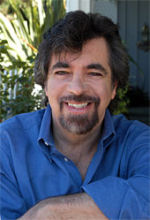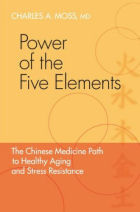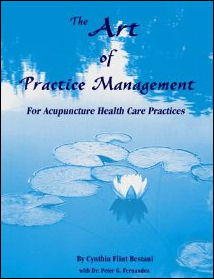Acupuncture & TCM Articles

Neil R. Gumenick is the founder and Director of The Institute of Classical Five-Element Acupuncture. Neil is a Worsley certified advanced teacher of Classical Five-Element Acupuncture and a practitioner with over 27 years of private practice experience. Neil holds three degrees from the College of Traditional Acupuncture (U.K.), and he participated for 10 years in the Master Apprentice Programô, led by Profs. J.R. & J.B. Worsley. Neil has taught at the USC and UCLA Schools of Medicine, the Worsley Institute of Classical Acupuncture, the Traditional Acupuncture Foundation, California Acupuncture College, Santa Barbara College of Oriental Medicine, and Pacific College of Oriental Medicine. He has been a Professor at Emperor's College of Traditional Oriental Medicine and SAMRA University of Oriental Medicine. Neil is co-author of The Art of Practice Management for Acupuncture Health Care Practices
The Initial Consultation: Getting to the Heart of the Matter, Part 9
By Neil Gumenick, MAc (UK), LAc, Dipl. Ac
In previous articles of this series, I stressed the importance of entering into the initial consultation with no agenda or assumptions, but with an attitude of simple curiosity. In such a state, we are receptive to the vast amounts of information with which we will be presented.
Filled with our own mental chatter, we cannot truly be present to the needs of the patient. We see and hear our own mind, not the patient.
My teacher, J.R. Worsley, taught us to be vigilant in leaving ourselves (and our personal processes) outside the treatment room. I have made a ritual of remembering this simple, but profound teaching in the act of touching the knob of the treatment room door. In that moment, I remember to leave Neil outside.
 
This is not to claim that during my time with the patient, I do not forget, but when I have become conscious that I have forgotten, I simply hit the "reset" button and start anew. I ask a question, prompted by curiosity, placing my attention on the patient. I do this because I know that when I am with my own thoughts and preoccupations, strivings to "get it right," make a good impression, say or do the "right things," I disconnect myself from the patient who is in front of me. Placing my focus on the patient, I disappear. Only consciousness remains; empty and receptive.
The Patient's Medical History
In this article, I will discuss ways of questioning the patient's medical history. As with all areas of inquiry, the goal is to get an accurate report of information to provide a baseline against which we can measure a patient's progress, as well as to learn who the patient is beneath the levels of information or data. Knowing who the patient is; their symptoms, primary elemental imbalance (causative factor), reactions, feelings, thoughts, emotional states and spiritual needs must all be considered in devising the treatment that will meet his needs.
I typically ask about a patient's medical history in this fashion: "Beginning with your birth, and moving forward chronologically, tell me what you have had in the way of illnesses, allergies, operations, medications, traumas, periods of poor health or recurring health problems." With such an open-ended question, I give the patient license to express, in their own words, that which they consider significant. Some patients will simply reply, "Oh, I've had all the usual childhood diseases" or "I've never been sick." I do not accept generalizations, and am prompted to follow with, "What childhood diseases did you have?" or "Really, have you never been sick a day in your life?" As always, I am paying attention to how the patient answers my questions. Some will laugh the questions off; others will be angered by my pressing for further information; others will become dismissive, needy, fearful and so on.
To some people, their medical history and current medical problems are the most important and central aspect of their lives and identities. To others, the question may seem irrelevant. Their reactions, expressed by their sound and emotion (as well as their facial color and odor) will lead me to the elemental cause of their trouble. The information (or data) is of secondary importance diagnostically, but important in revealing how the Officials and elements have been affected over time and how the Law of Cure will likely manifest (see Part 8 of this series, December 2009). For example, the fact that a 30-year-old patient had eczema, which was suppressed with cortisone at age 18, does not necessarily mean that I will treat the Metal element (in spite of the fact that the skin is associated with the Lung, which belongs to the Metal element). My treatment will be directed to the causative factor. However, if the patient's skin symptoms return briefly during the course of treatment, I have evidence that real cure is taking place, as the reappearance of the suppressed symptom (cause for celebration, not alarm!) means that the patient has cleared out back to the age of 18.
At any juncture in the telling of the medical history, if a window of opportunity is presented for me to question deeper, if my curiosity is piqued, if I have an emotional response, I question further and respond to and with my curiosity. If a particular illness or condition caused the patient undue hardship, for example, I might offer genuine sympathy, accompanied by words such as, "That must have been a terrible time for you." Then, I note how the patient responds to my response. If the patient loves the sympathy (or rejects it), I note it. If, for example, they respond with anger (joy, sadness, grief, or fear), I note that as well.
At the same time, I allow their emotion to pass through me, feel it, and adjust accordingly. This is the dance. It is really no different than two people having a normal conversation, except that rather than a simple exchange of informational chit-chat, as a practitioner, I am paying attention to how the patient is expressing themselves, noting what continually stands out as inappropriate, either by over-expression or absence of expression. This is what Worsley called listening to the "music behind the words." For a detailed discussion of this concept, please refer to Part 1 of this series on the subject of determining appropriateness.
A Case Study
As part of the inquiry about medical history, I want to know if the patient's birth was problematic or easy. Many patients know something of the story of their birth, particularly if it was in some way out of the ordinary. I recall one patient revealing that his mother never tired of recounting that she almost died during his birth, and virtually held him as an emotional hostage with guilt over this for his whole life. His reaction was one of shame for simply being alive, and a life-long compensating mechanism of people pleasing and being the "good" boy. He longed for acknowledgement and approval, and strove to be the best at any undertaking. His best was never sufficient in his eyes, in spite of the acknowledgement he received from the outside world. His major presenting complaint was anxiety, never feeling calm and always imagining the worst possible future scenario. Though he understood intellectually that these were fantasies of his own creation, he could neither control nor subdue them.
His odor was rotten, his color white, his sound weeping, and his emotion grief. I determined, based on these sensory indicators, that his causative factor was Metal.
Based upon my interaction with him, it was clear that his spirit level had been most compromised. In treating points for their spiritual connotations, we are not treating Spirit itself. Spirit needs no treatment or adjustment. Pure consciousness is innately pure and perfect. Rather, it is our perception of spirit that may be in need of treatment; clearing away that which obscures or pollutes our awareness.
The Points
After clearing several entry/exit blocks (discussed at length in my article, "Entry and Exit Points and Blocks," March 2006), I chose from among the following points to assist this patient at his specific level of need. (Note: In this system of acupuncture, points on the Du, Ren, Upper Kidney Chest, and Outer Bladder line on the back can be used for their spiritual connotations and conjoined with points on any element determined to be the patient's causative factor.)
Governing Vessel (Du) 14 Great Hammer: This point was chosen for this patient to break up old, ingrained patterns of thought, habitual ways of being and inertia. He had become resigned to how things were. His Officials had become lazy and unwilling to move. He had years of therapy and talked endlessly about his problems, but was stuck in a cycle of attachment such that his identity had basically become his problems, worries and anxieties. Gentle coaxing would not have sufficed to move his Officials to let go of the old, stale debris they were constantly recycling. Thus, Great Hammer was chosen to give the Officials a much needed "kick start" to get them moving.
Kidney 24 Spirit Burial Ground: This is the best point on the body to resuscitate a seemingly dead spirit that has been so traumatized that it is as if buried. This patient was able to articulate, even intellectually understand, his predicament. He had been over it hundreds of times, but there had been no real change, as the Spirit was not present. Without it, acupuncture treatment would have been yet another futile attempt to "figure it out." Only Spirit has the power to truly bring forth transformation and transcendence.
Large Intestine 7 Warm Current: This point was used to help this patient let go of the old, stale, and ingrained beliefs to which he had become so attached. A current is an ongoing flow of water that cleanses and washes away what is unclean. Warmth brings comfort, ease and relaxation. This patient had become rigid, cold and inflexible. The warmth of this current allowed him to soften, become malleable, relaxed and able to let go. It brought the quality of good humor and cheer to a process, which had for so long seemed deadly serious and insurmountable.
Lung 10 Fish Region: The Lung Official is called the "Receiver of Pure Qi from the Heavens." The light of Spirit must reach even the darkest and deepest of places. The point name reminds us of the depths of the sea. This patient had been living in darkness, unable to perceive the joy, warmth, light and inspiration that this point, the Fire point of the meridian, was able to bring forth. The image of the fish has long been a symbol of Christ consciousness - the Divine deep within, radiant and unobscured. Letting go of the old was necessary for this patient, as discussed in relation to LI 7 but seeing himself anew, through the clear eyes of Spirit, the gift of LU 10, was needed for him to move forward toward a new life.
 
The Art of Practice Management for Acupuncture Health Care Practices
What you will find in this book is a specific, comprehensive approach that gets to the root cause of success in practice.
This new book presents acupuncture practice as art from the standpoint of centering, qi, and wholeness. It builds on the premise that practices succeed from bridging inner and outer aspects of the self. It is an inquiry into the self and addresses clear understandings and approaches to reputable patient care and practice qi. It brings in the five elements and work with the seasons of practice from training and start-up to growth, stability, expansion and transformation. The authors artfully bridges the essence of both patient and practitioner well-being without excluding the practicalities of financial well-being. This book very specifically and extensively shows how the different parts of practice nourish and feed one another and are interdependent on one another for the qi to flow synchronistically.
It explores the dual nature of procedures that work and those which do not in acupuncture health care practice, returning again and again to the delicate balance of practicality and spirituality.
|
